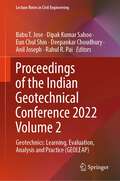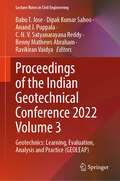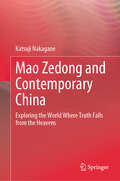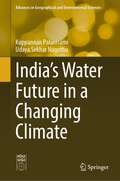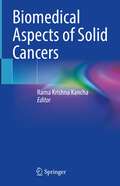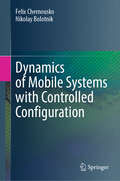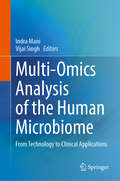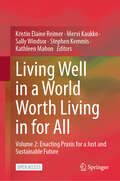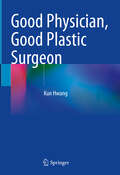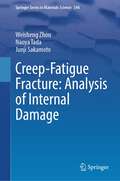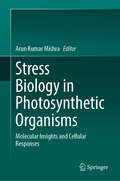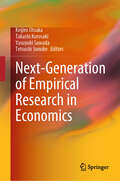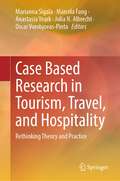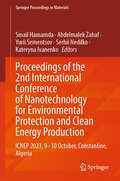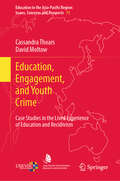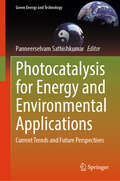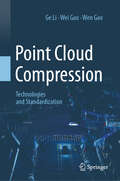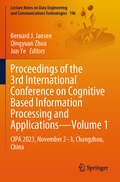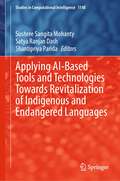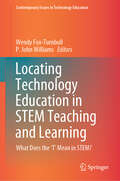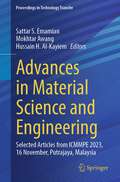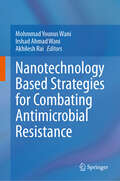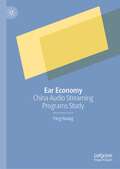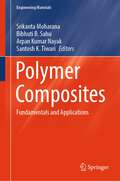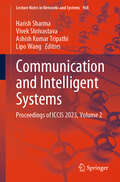- Table View
- List View
Proceedings of the Indian Geotechnical Conference 2022 Volume 2: Geotechnics: Learning, Evaluation, Analysis and Practice (GEOLEAP) (Lecture Notes in Civil Engineering #477)
by Deepankar Choudhury Anil Joseph Babu T. Jose Dipak Kumar Sahoo Eun Chul Shin Rahul R. PaiThis book comprises the select proceedings of the Indian Geotechnical Conference (IGC) 2022. The contents focus on recent developments in geotechnical engineering for a sustainable world. The book covers behaviour of soils and soil–structure interaction, soil stabilization, ground improvement and land reclamation, shallow and deep foundations, geotechnical, geological and geophysical investigation, rock engineering, tunnelling and underground structures, slope stability, landslides and liquefaction, earth retaining structures and deep excavations, geosynthetics engineering, geo-environmental engineering, sustainable geotechnics and landfill design, geo-hydrology, dam and embankment engineering, earthquake geotechnical engineering, transportation geotechnics, forensic geotechnical engineering and retrofitting of geotechnical structures, offshore geotechnics, marine geology and sub-sea site investigation, computational, analytical and numerical modelling, reliability in geotechnical engineering. The contents of this book are useful to researchers and professionals alike.
Proceedings of the Indian Geotechnical Conference 2022 Volume 3: Geotechnics: Learning, Evaluation, Analysis and Practice (GEOLEAP) (Lecture Notes in Civil Engineering #478)
by C. N. V. Satyanarayana Reddy Ravikiran Vaidya Babu T. Jose Dipak Kumar Sahoo Anand J. Puppala Benny Mathews AbrahamThis book comprises the select proceedings of the Indian Geotechnical Conference (IGC) 2022. The contents focus on recent developments in geotechnical engineering for a sustainable world. The book covers behavior of soils and soil–structure interaction, soil stabilization, ground improvement, and land reclamation, shallow and deep foundations, geotechnical, geological and geophysical investigation, rock engineering, tunneling and underground structures, slope stability, landslides and liquefaction, earth retaining structures and deep excavations, geosynthetics engineering, geo-environmental engineering, sustainable geotechnics, and landfill design, geo-hydrology, dam and embankment engineering, earthquake geotechnical engineering, transportation geotechnics, forensic geotechnical engineering and retrofitting of geotechnical structures, offshore geotechnics, marine geology and sub-sea site investigation, computational, analytical and numerical modeling, and reliability in geotechnical engineering. The contents of this book are useful to researchers and professionals alike.
Mao Zedong and Contemporary China: Exploring the World Where Truth Falls from the Heavens
by Katsuji NakaganeWhat did Mao Zedong bring to China? Mao Zedong, a rare leader who is still regarded as a great hero on the Chinese continent, despite the large number of victims caused by the Great Leap Forward and the Cultural Revolution. He called himself "Qin Shi Huang (First Emperor of Qin)plus Marx". It can be said that he is an entity that combines the power of the emperor and the authority of Marx into one person. This book analyzes the features of Mao Zedong’s thought and philosophy, his understanding of Marxism and class struggle, in particular, his peculiar attitude toward intellectuals, his actions leading to the Great Leap Forward and the Cultural Revolution, which he initiated and involved the entire nation, as well as the analysis of the mechanisms that caused such catastrophes and tragedies. Finally, through these analyses, this book attempts to evaluate Mao Zedong with diverse personalities and his behavior, positive and negative, whether in political, social, economic, or philosophical areas.
India's Water Future in a Changing Climate (Advances in Geographical and Environmental Sciences)
by Kuppannan Palanisami Udaya Sekhar NagothuThis book comprehensively addresses the most challenging water issues in India in a changing climate for the first time and suggests potential solutions. It has been observed that over the past two decades, water usage has significantly increased in India due to population growth, economic development and an increase in multiple uses of water, including irrigation, hydropower, industries, domestic consumption, fisheries, eco-system needs and the environment. India’s water future is mainly influenced by rising food demand to feed the increasing population, emerging climate change impacts on agriculture and the water sector, the increasing cost of interventions, poor cost recovery, the low level of technology adoption and weak water policy.Artificial recharge of the groundwater aquifers, improved water use efficiency and the groundwater–energy–agriculture nexus are important for the future of India’s water planning and are well addressed in this book. Also covered are climate-smart practices, wastewater reuse methods, and digital water and agriculture tools. The book further analyses improved irrigation modernization plans and explores the potential for micro-irrigation expansion including canal and tank irrigation systems in the country.Overall, this book is one of the first of its kind to present India’s future water and irrigation issues with field-based solutions, providing lessons learnt from successful national and international case studies. The volume is a useful resource for a wide range of readers including policy makers, planners, donors, implementing agencies and researchers in the water sector.
Biomedical Aspects of Solid Cancers
by Rama Krishna KanchaThis book offers an overview of the biological basis of 26 different solid cancers for scientists and oncologists to understand the clinical challenges. The book provides a quick, simplified, and updated review of the present genetic or genomic medicine era. With genetic and molecular details to enhance understanding of biological mechanisms underlying disease pathogenesis and treatment response, each chapter covers epidemiology, risk factors, classification, pathophysiology, genetics, and treatment of solid cancers.This book is a beginner’s guide for life sciences and medicine graduate students, fellows in training, biomedical sciences researchers, principal investigators, clinician-researchers and oncologists.
Dynamics of Mobile Systems with Controlled Configuration
by Felix Chernousko Nikolay BolotnikThe book discusses the dynamics and control of motion for mobile robots and other systems capable of moving in various environments by modifying their configurations. It is intended for researchers and engineers in theoretical and applied mechanics, robotics, control theory, and biomechanics. Additionally, graduate and post-graduate students studying these disciplines will find it a useful resource.
Multi-Omics Analysis of the Human Microbiome: From Technology to Clinical Applications
by Vijai Singh Indra ManiThis book introduces the rapidly evolving field of multi-omics in understanding the human microbiome. The book focuses on the technology used to generate multi-omics data, including advances in next-generation sequencing and other high-throughput methods. It also covers the application of artificial intelligence and machine learning algorithms to the analysis of multi-omics data, providing readers with an overview of the powerful computational tools that are driving innovation in this field. The chapter also explores the various bioinformatics databases and tools available for the analysis of multi-omics data. The book also delves into the application of multi-omics technology to the study of microbial diversity, including metagenomics, metatranscriptomics, and metaproteomics. The book also explores the use of these techniques to identify and characterize microbial communities in different environments, from the gut and oral microbiome to the skin microbiome and beyond. Towards theend, it focuses on the use of multi-omics in the study of microbial consortia, including mycology and the viral microbiome. The book also explores the potential of multi-omics to identify genes of biotechnological importance, providing readers with an understanding of the role that this technology could play in advancing biotech research. Finally, the book concludes with a discussion of the clinical applications of multi-omics technology, including its potential to identify disease biomarkers and develop personalized medicine approaches. Overall, this book provides readers with a comprehensive overview of this exciting field, highlighting the potential for multi-omics to transform our understanding of the microbial world.
Living Well in a World Worth Living in for All: Volume 2: Enacting Praxis for a Just and Sustainable Future
by Stephen Kemmis Kathleen Mahon Mervi Kaukko Kristin Elaine Reimer Sally WindsorThis open access book is the second of a two-volume series that explores how people are living well and creating a “World Worth Living in for All”. It engages in deep listening of voices from across the world and considers the role of education in creating a more just and sustainable world for the future. The book asks what can be learnt to create change in policy and practice in order to enact praxis. It showcases chapters from international authors who discuss current or new projects to address the overarching questions explored in the book. It also provides an overview of perspectives that connect both volumes and the individual projects presented together through the lens of practice architectures.
Good Physician, Good Plastic Surgeon
by Kun HwangThis book is based on over 100 editorials published in various international academic journals. Within its pages, the author engages in discussions with esteemed plastic surgeons, exploring the qualities that define a good plastic surgeon, the intricate connection between anatomy and plastic surgery, the concept of beauty, the process of aging, and the interplay between arts and plastic surgery. Each case presented in the book is both captivating and educational, with the author thoughtfully including a corresponding figure or schema for visual reference. This book promises to be an invaluable resource, particularly for young plastic surgeons or those undergoing plastic surgery training.
Creep-Fatigue Fracture: Analysis of Internal Damage (Springer Series in Materials Science #344)
by Junji Sakamoto Weisheng Zhou Naoya TadaThis book presents a detailed analysis of the processes of internal damage and healing of damage in high-temperature creep-fatigue. This analysis is based on experimental results and a three-dimensional visualization and simulation method. It focuses on inner cracking type fracture, which is essential to consider for creep-fatigue in actual equipment and structures used at high temperatures for long periods of time. In this book, systematic studies of the fracture are presented by introducing three-dimensional simulation and visualization methods. This book is for designers and researchers in industry specializing in strength of materials at high temperatures. It is also for a postgraduate or higher academic audience specializing in mechanical engineering and materials science engineering. In reading the book it is expected that readers will acquire knowledge of evaluation techniques for high-temperature creep-fatigue damage. In addition, this book allows readers toimprove the accuracy of damage evaluation, design materials for longer lifetimes, and apply the described techniques to other materials.
Stress Biology in Photosynthetic Organisms: Molecular Insights and Cellular Responses
by Arun Kumar MishraThis book explores the intricate mechanisms underlying the stress responses of phototrophs, which play a critical and foundational role in shaping and sustaining life on Earth.The photoautotrophic entities encounter a spectrum of natural and anthropogenic stresses, inducing a multitude of responses at the physiological, biochemical, genetic, and developmental levels. The comprehension of how these phototrophs adeptly counter stressors transcends mere scientific pursuit; it stands as an essential endeavor for predicting their adaptability in an ever-evolving world and, crucially, for conserving our delicate ecosystems. The book will shed light on the sophisticated interplay of stress signaling pathways and the nuanced engagement of stress-responsive hormones within these life forms. Furthermore, it unveils the cryptic genetic and epigenetic controls dictating stress-related gene expression, yielding profound insights into the enduring recollection of their responses to environmental challenges.This book is an essential read for researchers, educators, and students alike. It offers a comprehensive panorama of stress biology, unveiling the innermost mechanisms at play within photosynthetic organisms discussing their resilience and adaptation.
Next-Generation of Empirical Research in Economics
by Keijiro Otsuka Yasuyuki Sawada Tetsushi Sonobe Takashi KurosakiLeading Japanese economists passionately discuss the frontiers of empirical research in economics and the future of it in this book. The book explores the impact that recent econometrics and empirical research has had on labor economics, development economics, international trade theory, behavioral economics, economic history, and macroeconomics. Each chapter consists of a main text, comments, and replies by leading experts in each sub-discipline. Basic knowledge of statistics and qualitative economics is ideal, but not essential to appreciate the book. This book is ideal for students and scholars who wish to learn about cutting-edge empirical research in economics and learn how to apply it to their own research.
Case Based Research in Tourism, Travel, and Hospitality: Rethinking Theory and Practice
by Julia N. Albrecht Marianna Sigala Anastasia Yeark Marcela Fang Oscar Vorobjovas-PintaThis book consolidates case study based research in tourism, travel, hospitality, and events under one roof. It aims to consolidate cutting edge case study based research within the wider tourism industry that investigates topical and contemporary industry challenges and practices, which in turn can help tourism scholars to build new theory for advancing tourism research and educational practices. Case study based research is well recognised for its ability to develop theories and to support pedagogical aims. This book explores the repercussions of COVID-19 on tourism in how this has magnified the need and the urgency to use case based research and teaching. COVID-19 has accelerated profound changes in the tourism industry that are demonstrated in transformed: consumer profiles and behaviours; industry structures, business models and operations; and tourism labour markets. Subsequently, tourism educators, providers and researchers are required to study andaddress the abovementioned changes by undertaking transformational tourism research that can challenge and shift existing theories and knowledge frontiers, help industry and academia alike to reset new industry standards; and 2) develop tourism graduates that meet the new industry requirements, are resilient, flexible and adaptable, they possess transferable knowledge and skills that can solve real industry problems. The aim of this book to meets the market gap of books focusing on case study based research and teaching and further expands to address the COVID-19 repercussions and opportunities for tourism research and case studies.
Proceedings of the 2nd International Conference of Nanotechnology for Environmental Protection and Clean Energy Production: ICNEP 2023, 9–10 October, Constantine, Algeria (Springer Proceedings in Materials #45)
by Smail Hamamda Abdelmalek Zahaf Yurii Sementsov Serhii Nedilko Kateryna IvanenkoThis proceedings book covers the latest research and advancements in nanotechnology for environmental protection and clean energy production. It encompasses a wide range of topics, including physical-chemical nanomaterials science, nanoscale physics, nanocomposites and nanomaterials applications, solids and structures, renewable energy, nanoparticles, and metallic and polymer materials. While focusing on scientific advancements, this book highlights the practical applications of nanotechnology in environmental protection and clean energy production. It bridges the gap between theory and real-world implementation, making it a valuable resource for researchers, students, and professionals seeking practical insights and solutions.
Education, Engagement, and Youth Crime: Case Studies in the Lived Experience of Education and Recidivism (Education in the Asia-Pacific Region: Issues, Concerns and Prospects #71)
by Cassandra Thoars David MoltowThis book presents insights into how affective educational experiences may be associated with youth criminal behaviour and the pathway to recidivism. It explores the perspectives and lived school experiences of five young adult male prison inmates, including while they were incarcerated as youths. Through these case studies, the book explores the relationship between affective engagement in education and recidivism.This book shows that participants were affectively disengaged from education prior to their initial incarceration in a youth detention facility, and that their disaffection before, during, and after youth incarceration both generated and impacted on their cognitive and behavioural disengagement from education. Moreover, a range of additional factors not directly causally related to their schooling were shown to have had a significant effect on their engagement in education. The book considers a number of key findings. First, the foundational role that a sense of belonging plays in how young people experience education and its relation to crime. Second, the importance of individualized transition plans for youth at risk, and youth offenders before, during, and after incarceration. Third, the extent to which successful transition from youth offending and recidivism hinges on interagency collaboration. This book will be beneficial to teacher educators, education researchers, criminologists and sociologists.
Photocatalysis for Energy and Environmental Applications: Current Trends and Future Perspectives (Green Energy and Technology)
by Panneerselvam SathishkumarThis book presents the existing photocatalytic reactor design and the future developments and the progress needed for both solar light-driven hydrogen generation and environmental purification. The chapters discuss the renewable and commercial aspects of translucent polymer-linked heterojunction nanocomposites as visible light-responsive photocatalysts. Relevant to these areas, the field of growing interest in black-TiO2, perovskites, MXenes and their numerous applications are presented. The framework, structural features and the need of mesocrystals for solar light-driven photocatalysis are also included. The book also discusses the additional features of green chemistry-based synthesis of nanomaterials in order to reduce any secondary pollution that may be released in the environment due to unsafe disposal of solvents. In addition, the importance of bismuth-based nanophotocatalysts towards energy and environmental applications and their future development as alternative photocatalysts for the prevailing nanomaterials are presented. The book also touches upon the idea to generate green fuel hydrogen through photocatalytic and photoelectrochemical techniques. Overall the book highlights contemporary developments in the last decade, the future perspectives of photocatalysis and its application towards energy and environment.
Point Cloud Compression: Technologies and Standardization
by Wen Gao Wei Gao Ge Li3D point clouds have broad applications across various industries and have contributed to advancements in fields such as autonomous driving, immersive media, metaverse, and cultural heritage protection. With the fast growth of 3D point cloud data and its applications, the need for efficient compression technologies has become paramount. This book delves into the forefront of point cloud compression, exploring key technologies, standardization efforts, and future prospects. This comprehensive book uncovers the foundational concepts, data acquisition methods, and datasets associated with point cloud compression. By examining the fundamental compression technologies, readers can obtain a clear understanding of prediction coding, transform coding, quantization techniques, and entropy coding. Through vivid illustrations and examples, the book elucidates how these techniques have evolved over the years and their potentials for the future. To provide a complete picture, the book presents cutting-edge research methods in point cloud compression and facilitates comparisons among them. Readers can be equipped with an in-depth understanding of the latest advancements, and can gain insights into the various approaches employed in this dynamic field. Another distinguishing aspect of this book is its exploration of standardization works for point cloud compression. Notable standards, such as MPEG G-PCC, AVS PCC, and MPEG V-PCC, are thoroughly illustrated. By delving into the methods used in geometry-based, video-based, and deep learning-based compression, readers become familiar with the latest breakthroughs in the standard communities.
Proceedings of the 3rd International Conference on Cognitive Based Information Processing and Applications–Volume 1: CIPA 2023, November 2–3, Changzhou, China (Lecture Notes on Data Engineering and Communications Technologies #196)
by Jun Ye Bernard J. Jansen Qingyuan ZhouThis book contains papers presented at the 3rd International Conference on Cognitive- based Information Processing and Applications (CIPA) in Changzhou, China, from November 2–3, 2023. The papers represent the various technological advancements in theory, technology and application of artificial intelligence, including precision mining, intelligent computing, deep learning, and all other theories, models, and technologies related to artificial intelligence. It caters to postgraduate students, researchers, and practitioners specializing and working in the area of cognitive-inspired computing and intelligent computing. The book represents Volume 1 for this conference proceedings, which consists of a 3-volume book series.
Applying AI-Based Tools and Technologies Towards Revitalization of Indigenous and Endangered Languages (Studies in Computational Intelligence #1148)
by Satya Ranjan Dash Shantipriya Parida Sushree Sangita MohantyThis book emphasises the need for language resource development and its impact on society. It covers latest AI based tools and techniques used to preserve indigenous and endangered languages. The book also highlights latest AI based technologies such as Generative Pre-trained Transformer (GPT) towards endangered language preservation. It discusses morphology analysis, translation support and shallow parsing of various tribal languages of India and abroad. This book tries to answer how digital technologies can make language revitalization accessible to future generations.
Locating Technology Education in STEM Teaching and Learning: What Does the ‘T’ Mean in STEM? (Contemporary Issues in Technology Education)
by Wendy Fox-Turnbull P. John WilliamsThis book offers clarity and consistency of thinking in relation to Technology Education when situated within a STEM approach to teaching. It examines the range of Innovations and Issues which are being considered by schools as they implement STEM, with particular focus on the place of Technology, or the ‘T’ in STEM. The book is divided into three sections: Philosophy, Implementation and Issues and Innovations, with each containing five to seven chapters. The first section lays the foundations for the remainder of the book: it focuses the readers on the technology aspect of STEM education and situates it to align with the international understanding of technology education. The second section provides insights into how STEM is best implemented to give technology due consideration across a range of disciplines with technology education, including engineering, food technology, and textile technology. This section also provides suggestions for the successful implementation of the STEM approach, and offers further insight through a range of case studies. The third section outlines and discusses a range of issues that pose a threat to the position and understanding of technology within the STEM teaching and learning approach. This section also examines how technology and STEM are situated within, are supported or are threatened by, other current innovations and approaches to teaching an integrated curriculum, such as the Maker Space Movement and Play-based Learning.
Advances in Material Science and Engineering: Selected articles from ICMMPE 2023, 16-Nov, Putrajaya, Malaysia (Proceedings in Technology Transfer)
by Mokhtar Awang Hussain H. Al-Kayiem Sattar S. EmamianThis book presents the latest research advancements in the field of material science, specifically in mechanical, manufacturing, and plant engineering. It includes peer reviewed articles from the 9th International Conference on Mechanical, Manufacturing and Plant Engineering (ICMMPE 2023) held on 16th November 2023 at The Everly Hotel Putrajaya, Malaysia. The conference showcases cutting-edge research and facilitates knowledge exchange among experts in the field of material science, mechanical engineering and their applications.
Nanotechnology Based Strategies for Combating Antimicrobial Resistance
by Mohmmad Younus Wani Irshad Ahmad Wani Akhilesh RaiThis book provides a comprehensive overview of recent advances in nanotechnology as an alternative strategy for addressing antimicrobial resistance (AMR). Examining nanotechnology-based methods such as nanoencapsulation, drug delivery, and conjugation, the text highlights their successful application in treating microbial infections with reduced resistance and off-target toxicity. The introductory section outlines AMR and explores diverse mechanisms of microbial resistance, emphasizing the potential of nanotechnology to surmount these challenges. Subsequent chapters investigate the role of specific nanomaterials—metal nanoparticles, metal oxide nanoparticles, functionalized quantum dots, magnetic nanoparticles, bimetallic nanoparticles, nanocomposites, carbon nanomaterials, and polymer-based nanomaterials—in overcoming antimicrobial resistance. Several chapters focus on the efficacy of nanoemulsions as an antimicrobial delivery method, underscoring their inherent antimicrobial properties, capacity to enhance drug solubility, stability, bioavailability, and targeting potential at the organ and cellular levels. The concluding section provides a detailed review of liposomes, dendrimers-based nanoparticles, and micelles as drug delivery vehicles in the context of combating pathogens resistant to antimicrobials.
Ear Economy: China Audio Streaming Programs Study
by Ying HuangThis book sheds light on the overall description and explanation of the current socio-political, economic and cultural environment concerning the development of China's audio streaming programs industry. It interprets the emergence of the “ear economy” through the subjects of media ecology, media psychology, communication studies and cultural criticism, media industrial studies, sociology and anthropology. The book skillfully weaves together historical, cultural, and industry studies, along with textual and critical discourse analysis. This interdisciplinary work contributes to multiple academic fields including literary and cultural studies, media and communication studies, China/Asia studies, and political theory.
Polymer Composites: Fundamentals and Applications (Engineering Materials)
by Santosh K. Tiwari Srikanta Moharana Bibhuti B. Sahu Arpan Kumar NayakThis book highlights the fundamentals and recent advances for developing novel polymer composites for various applications, including 3D printing, automotive, textiles, agriculture, nanogenerators, energy storage and biomedical engineering. It presents various facile processing techniques to prepare polymeric composites with attractive properties like mechanical strength, flexibility, thermal & electrical performances for end used applications from bench to field. This in-sight of properties, performances and utility will lead to technological applications of polymer composites. It provides a platform for evolving and expanding technological solutions for challenges in the contemporary world, and presents a concrete path for advancement in this domain of polymer composite for professionals, researchers, material scientists, and students.
Communication and Intelligent Systems: Proceedings of ICCIS 2023, Volume 2 (Lecture Notes in Networks and Systems #968)
by Lipo Wang Harish Sharma Vivek Shrivastava Ashish Kumar TripathiThis book gathers selected research papers presented at the Fifth International Conference on Communication and Intelligent Systems (ICCIS 2023), organized by Malaviya National Institute of Technology Jaipur, India, during December 16–17, 2023. This book presents a collection of state-of-the-art research work involving cutting-edge technologies for communication and intelligent systems. Over the past few years, advances in artificial intelligence and machine learning have sparked new research efforts around the globe, which explore novel ways of developing intelligent systems and smart communication technologies. The book presents single- and multi-disciplinary research on these themes to make the latest results available in a single, readily accessible source. The work is presented in three volumes.
